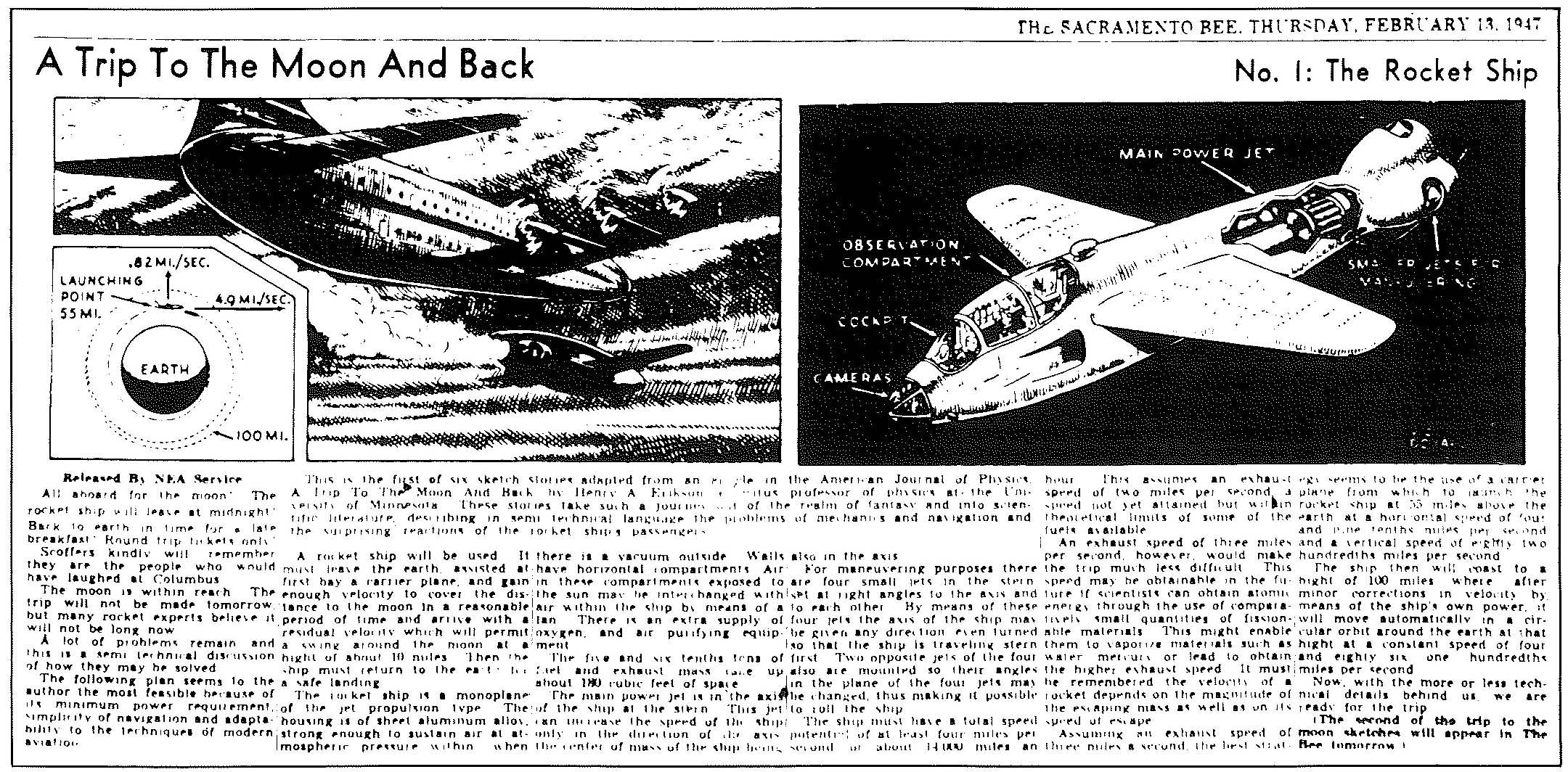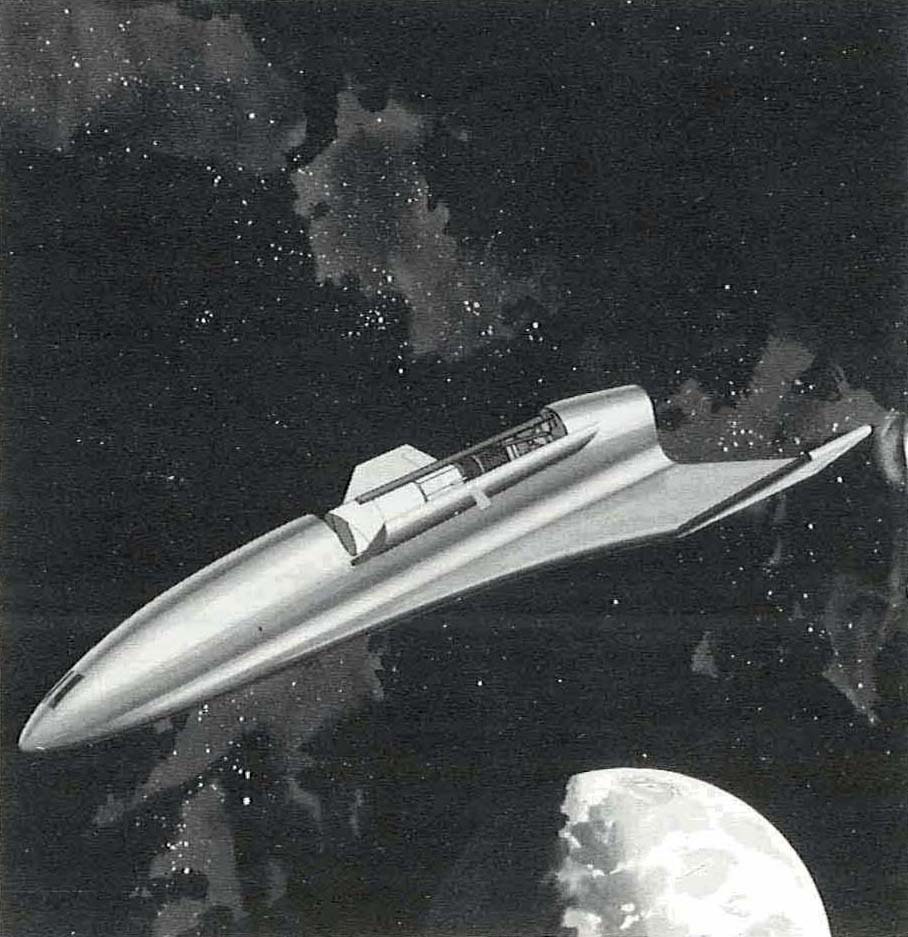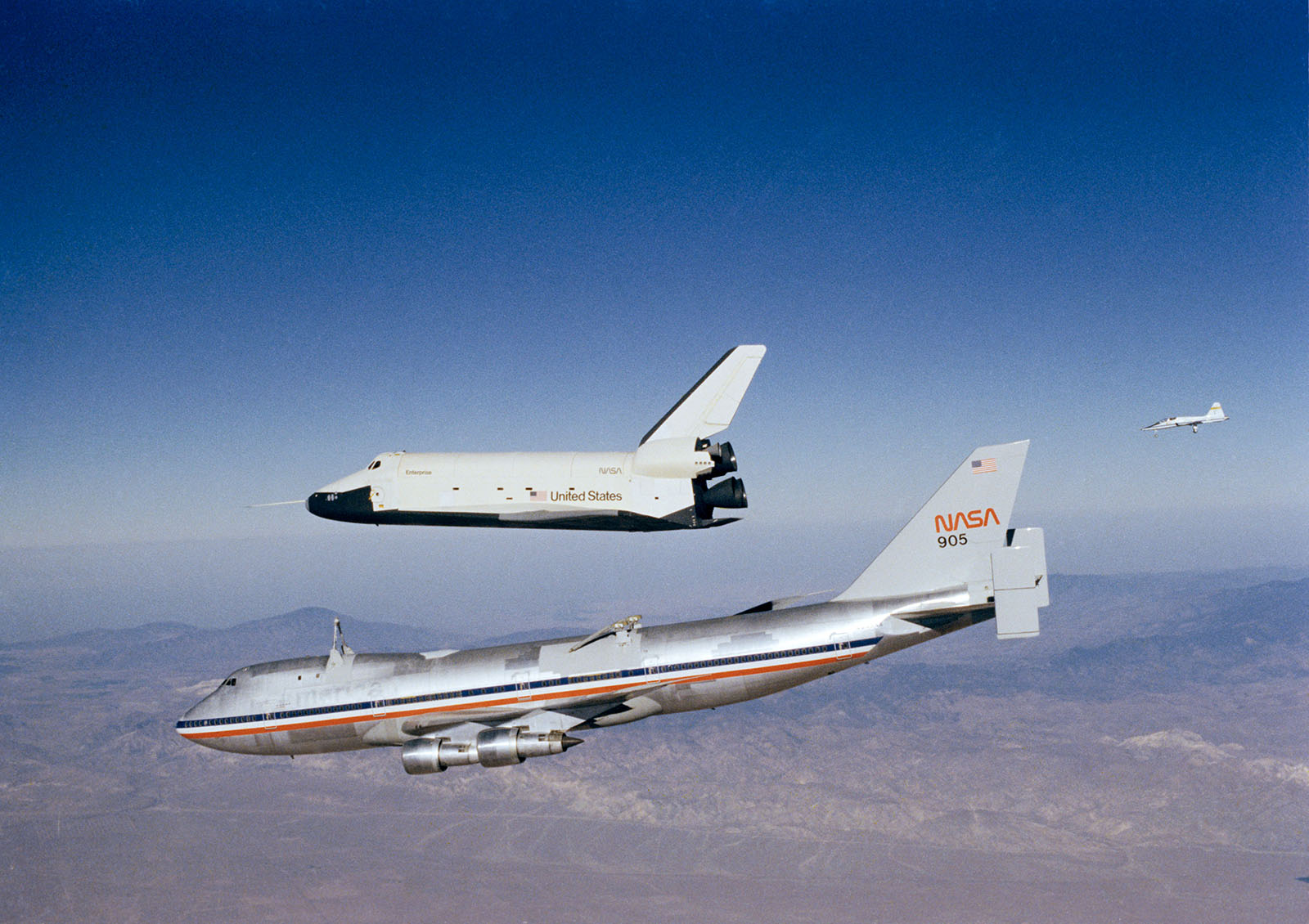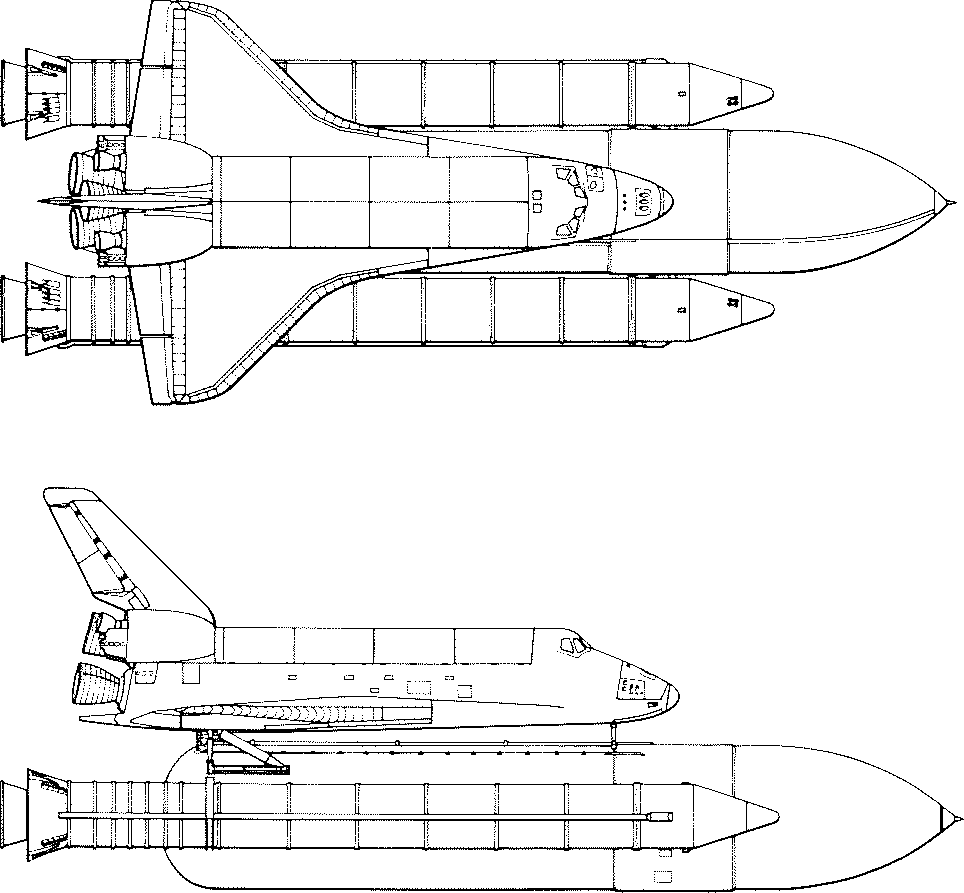4. What Shaped the Design
Years before even the first sputnik, scientists and aeronautical engineers recognized that economical, everyday use of space would require a transportation system employing vehicles that could make repeated voyages into space and return.
Newspapers in 1947 carried a series of imaginative stories describing “A Trip to the Moon and Back” that showed airplane-like rocket ships. In 1954 Colliers magazine published articles by Werner von Braun and his associates popularizing the idea and economic advantages of Earth-to-orbit cargo carriers that would be recovered for repeated use. A paper given at the 1958 meeting of the American Rocket Society was entitled “Commercial Rocket Airplane: A Connecting Link to Manned Space Flight.”



However, the technology needed for building returnable, reusable spacecraft was not yet in hand, particularly knowledge of how to design long lived, high-performance rocket engines and insulation that wouldn’t burn away in a single fiery re-entry into the atmosphere. The urgency of ballistic missiles and the perceived need to compete with the Russians in manned flight, moreover, kept American emphasis in the 1950s on conventional rocketry. One program to advance the technology called Dynasoar, for dynamic soaring, using a vehicle that would bounce off the upper atmosphere, like a skipping stone—was begun by the Air Force but canceled. NASA studied an idea called Head-End Steering. This involved putting a man-carrying, flatiron-shaped lifting body on the nose of a big rocket of very simple design. Expensive guidance and control equipment would be located in the lifting body, which could maneuver in the atmosphere after its reentry from orbit and be recovered for repeated trips but the booster rocket still would have been expendable. This scheme was dropped because it didn’t seem to offer much advantage over the simpler ballistic-capsule approach being worked out for the Mercury, Gemini, and Apollo programs.
By the early 1960s engineers studying the weight, propulsion, and thermal problems saw no practical way to design a single aircraft-spacecraft that would make the trip into orbit by itself with worthwhile loads and return. An economical system required two vehicles: a reusable cargo carrier plus some kind of booster to help it into orbit. Whether the booster also should be reusable was debated at length. Juxtaposed articles in the January 1963 issue of Astronautics magazine emphasized the greater operating economy but higher original development costs of “a winged, recoverable rocket-powered launch system.”
Through the decade uncounted engineers in Europe as well as the United States pondered various proposals for wholly or partly reusable Earth-to-orbit transportation concepts. The European Space Research Organization (ESRO)-now the European Space Agency—initiated studies involving industrial groups throughout western Europe. Titles of some of the papers given at a U.S. European conference on Low Cost Space Transportation in 1967 indicate the wide variety of ideas explored: “French Concept for an Aerospace Transporter”. . . “A West German Approach to Reusable Launch Vehicles” . . . “A British Reusable Booster Concept” . . . “Air-Breathing Reusable Launchers” . . . “The Enigma of Booster Recovery-Ballistic or Winged?” . . . “A Comparison of Fixed Wing Reusable Booster Concepts.” Meantime, aerospace technology was being advanced by flight research with the X-15 rocket plane and lifting bodies, operational experience in Mercury, Gemini, and Apollo, and the development of supersonic military and transport aircraft. A series of studies for NASA, reported at a Space Shuttle conference in Washington in the fall of 1969, concluded that building a reusable space transportation system was now becoming technically feasible and economically justified.
Before even the first Apollo flight, U.S. policy planners were shifting their sights to low-cost use of space for practical purposes. The President’s Science Advisory Committee in February 1967 said: “For the longer range, studies should be made of more economical ferrying systems, presumably involving partial or total recovery and use.” In September 1969, two months after the first Moon landing, in a report to a task group established by the President to outline the future of the U.S. space program, NASA recommended building “ .. a low unit-mission-cost transportation system that would make Earth-Moon space easily and economically accessible to man for his use for exploration, applications, science, and technology research.” The head of the manned flight program, George E. Mueller, wrote: “No law says space must be expensive.” In March 1970 the President announced that a major objective of the U.S. space program was to reduce substantially the cost of space operations. A reusable transportation system to shuttle between Earth and orbit was identified as a way of achieving this.
Two years of detailed feasibility, engineering, and economic studies by NASA, aerospace companies, and academic groups focused on a fully reusable two-stage, piggyback vehicle that would take off vertically and land horizontally. Each stage would carry its own fuel in internal tanks. When the first stage ran out, the second stage would continue its climb into orbit while the first returned to land on a runway. Since no tanks were to be dropped, the pair could take off without concern about passing over populated areas in the early part of the flight.
Each stage would have a crew of two. The second, orbital stage could carry, in addition, twelve passengers, since one of its main jobs would be to ferry replacement crews, as well as supplies, to a permanent space station. The cargo bay would be big enough to carry up modules from which the station could be assembled in orbit. Both stages would have new high-pressure hydrogen-oxygen rocket engines, two or three for the Orbiter and ten or twelve for the booster. The engines would be capable of repeated use and of being throttled back to half power to keep acceleration during ascent to less than three times normal gravity. This was important for crew and passenger comfort and would permit carrying less rugged, and therefore cheaper, payloads that would not be damaged by high acceleration and vibration. Engines were recognized as the pacing item in the Shuttle development, as they proved
Two configurations for the Orbiter were considered. One had stubby, straight wings and was designed for reentry at a high angle of attack, which reduced extreme heating from air friction but also reduced maneuverability from side to side of the descent track that might be needed for an emergency landing. The second was a delta or triangular shape that could renter at a lower angle of attack, permitting greater cross-range maneuvering but also causing greater heating of the nose, leading edges, and underside of the fuselage and thus complicating the problems of designing adequate thermal protection. The systems analysts, weighing advantages and disadvantages, chose the delta shape.



The very success of Apollo in beating the Russians to the Moon, and the subsequent trend toward reducing the annual cost of the U.S. space program, then forced a major change in the Shuttle design. The ultimate operating cost of a fully reusable vehicle would be lower than that of systems using some simpler, expendable elements; but the original development costs would probably have been more than $10 billion-1971 dollars—for two large piloted vehicles, both possessing features of a rocket launch vehicle and a supersonic aircraft. This seemed more than successive administrations and Congresses were likely to provide.
A search for ways to reduce the cost came up with a smaller, more efficient Orbiter with external, expendable hydrogen tanks; and the booster’s top speed was lowered to permit the use of less expensive heat shielding. These changes cut the prospective price about 20 percent but not enough. So both the liquid oxygen and liquid hydrogen tanks were removed from the Orbiter in favor of a single expendable combined tank, divided to carry both propellants, further reducing the Orbiter’s size and development cost but not its performance.
With the Orbiter configuration essentially settled, the final major decision was to resolve the booster issue. Charles I. Donlan, a leader in these studies, has described the interlocking engineering and economic tradeoffs and choices:
Partly to save money and partly because of worries about the safety of the booster crew in the event of a malfunction or aborted flight, the planners decided to give up the manned booster. An unmanned one then presented the choice of liquid-propellant or solid-fuel rocket motors. Liquid engines in a series-burn configuration, where the Orbiter engines would be ignited after the booster had shut down and separated, were compared with solid rockets that would be ignited simultaneously with the Orbiter engines at liftoff and burn in parallel during the initial ascent.
Because of the high price of a liquid-fuel booster, it would be important that each one be recovered, refurbished, and reused. This was not so critical for the cheaper solid-fuel rocket. In effect, the cost of discarding a liquid booster would be so much greater than discarding a solid that its use would impair the ability of the Shuttle to maintain the low cost of recurrent operations that was its major objective. Recovering a liquid booster would also be more complicated and expensive. Most of all, while the cost per flight would be higher with recoverable solid boosters and an expendable hydrogen-oxygen tank (fueling engines of a recoverable orbiter) than with the fully reusable vehicle originally favored, their choice would cut the program development cost almost in half. In the face of tight budgets, the decision seemed obvious.
On January 5, 1972, the President stated:
The United States should proceed at once with the development of an entirely new type of space transportation system designed to help transform the space frontier of the 1970s into familiar territory, easily accessible for human endeavor in the 1980s and ’90s. . . . It will revolutionize transportation into near space by routinizing it. . . . It will take the astronomical costs out of astronautics. . . . This is why commitment to the space Shuttle program is the right next step for America to take.
Separate solid-fuel rockets for abort from the launch pad and flyback jet engines for the Orbiter were later dropped to simplify the design and save weight, but other changes were minor through seven years of development, elaborate testing, and initial production.
The three-part configuration selected by NASA on March 15, 1972-reusable Orbiter, partly reusable Solid Rocket Boosters, and expendable External Tank- is essentially the Space Shuttle of today.